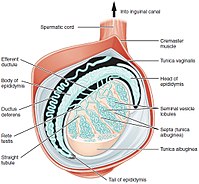
Photo from wikipedia
Background Mammals have wide variations in testicular position, with scrotal testes in some species and ascrotal testes in others. Although cryptorchidism is hazardous to human health, some mammalian taxa are… Click to show full abstract
Background Mammals have wide variations in testicular position, with scrotal testes in some species and ascrotal testes in others. Although cryptorchidism is hazardous to human health, some mammalian taxa are natural cryptorchids. However, the evolution of testicular position and the molecular mechanisms underlying the maintenance of health, including reproductive health, in ascrotal mammals are not clear. Results In the present study, comparative genomics and evolutionary analyses revealed that genes associated with the extracellular matrix and muscle, contributing to the development of the gubernaculum, were involved in the evolution of testicular position in mammals. Moreover, genes related to testicular position were significantly associated with spermatogenesis and sperm fertility. These genes showed rapid evolution and the signature of positive selection, with specific substitutions in ascrotal mammals. Genes associated with testicular position were significantly enriched in functions and pathways related to cancer, DNA repair, DNA replication, and autophagy. Conclusions Our results revealed that alterations in gubernaculum development contributed to the evolution of testicular position in mammals and provided the first support for two hypotheses for variation in testicular position in mammals, the “cooling hypothesis”, which proposes that the scrotum provides a cool environment for acutely heat-sensitive sperm and the “training hypothesis”, which proposes that the scrotum develops the sperm by exposing them to an exterior environment. Further, we identified cancer resistance and DNA repair as potential protective mechanisms in natural cryptorchids. These findings provide general insights into cryptorchidism and have implications for health and infertility both in humans and domestic mammals.
Journal Title: BMC Genomics
Year Published: 2021
Link to full text (if available)
Share on Social Media: Sign Up to like & get
recommendations!